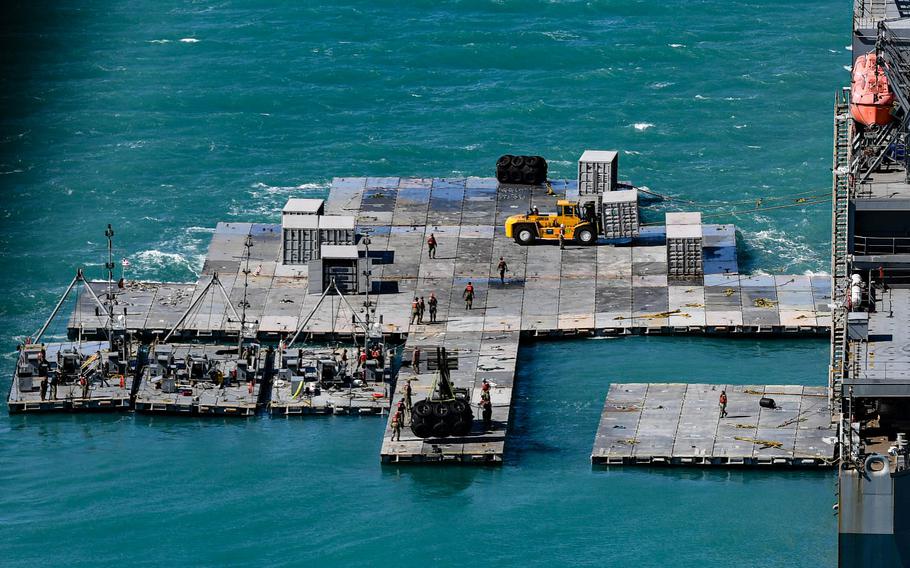U.S. Army Vessel General Frank S. Besson (LSV-1) from the 7th Transportation Brigade (Expeditionary), 3rd Expeditionary Sustainment Command, XVIII Airborne Corps, prepares to depart Joint Base Langley-Eustis, Va., Saturday, March 9, 2024. (U.S. Central Command)
The Pentagon will soon deploy about 1,000 American troops to build a temporary seaport just off the coast of war-torn Gaza to provide its inhabitants some 2 million meals per day, a Defense Department spokesman said Friday.
The American troops will deploy a floating pier and a roughly 1,800-foot causeway in the Mediterranean Sea off Gaza’s coast, where commercial vessels can dock and offload aid to be transported by smaller vessels and vehicles into Gaza, said Air Force Maj. Gen. Pat Ryder, the Pentagon’s top spokesman.
The operation will use a makeshift dock known as a Joint Logistics Over-the-Shore, or JLOTS, and include Navy and Army personnel, Ryder said.
None of the American forces will enter Gaza at any time, including to deliver aid or build the temporary pier, he said at the Pentagon. Ryder said the pier should be operational within about 60 days.
“We’re working to set this up as quickly as possible, but we expect that it will take several weeks to plan and execute,” he said. “Once operational the actual amount of aid delivered will depend on many variables and will likely scale over time. However, we expect that deliveries via JLOTS could provide more than 2 million meals to the citizens of Gaza per day.”
Not all the forces to be used in the operation had been selected as of Friday, Ryder said. However, the Army’s 7th Transportation Brigade based at Joint Base Langley-Eustis in Virginia had already been notified it would be deployed, he said. That unit is described by the Army as its JLOTS experts.
President Joe Biden announced Thursday during his State of the Union speech that he ordered the Pentagon to conduct the new aid mission. He also called on Israel to do more to protect civilians and ensure they receive humanitarian aid as the Israelis fight Hamas militants in the Palestinian enclave.
The U.N. said the roughly 2.3 million people in Gaza now face near-famine conditions amid the fighting launched in the wake of Hamas militants’ surprise assault on Israelis on Oct. 7.

Army mariners work to construct a causeway off the coast of Bowen, Australia, on July 28, 2023. The causeway forms a floating pier enabling the discharge of equipment to shore showing the capability of Joint Logistics Over-the-Shore, or JLOTS. (David Resnick/U.S. Army)
Humanitarian aid has been slow getting into Gaza for reasons including blockades at land crossings and tight controls of aid trucks by Israel, which has accused Hamas of stealing humanitarian goods.
The United States in recent days has begun airdropping some humanitarian aid into Gaza via Air Force C-130s. The U.S. and Jordanian militaries airdropped about 11,500 meals into northern Gaza on Friday, according to U.S. Central Command, which oversees American military operations in the Middle East. To date, the United States has airdropped about 124,000 meals to Gazans, Ryder said.
He also said the U.S. would continue to press Israel to allow more humanitarian aid into Gaza via land crossings, but it would continue to work to find creative ways to get meals to the enclave’s civilians.
“This is part of a full-court press by the United States to not only focus on working on opening up and expanding routes via land — which of course are the optimal way to get aid into Gaza — but also by conducting air drops, and now, as the president has said, not enough aid is getting in, and so this is a capability that we have [and] it’s a capability that we are going to execute,” the general said.
It was not clear Friday how much the new aid operations would cost U.S. taxpayers, Ryder said.
The Navy will deploy the floating pier and causeway toward Gaza via ships, and soldiers and sailors will prepare them for use, Ryder said. Commercial vessels will be able to dock at the floating pier, where their cargo can be offloaded and reloaded onto smaller Navy logistics support vessels, he said.
Those Navy ships will then deliver the aid onto the causeway, where it will be loaded onto trucks that will drive it onto the beach in Gaza for delivery, Ryder said.
The aid will be driven into Gaza by vetted U.S. partners and not American troops, he said. The U.S. was in talks with partner nations, nongovernmental organizations and Israel about who would conduct those operations.
“The concept that is being planned involves the presence of U.S. military personnel on military vessels offshore but does not require U.S. military personnel to go ashore,” Ryder said.
He said the U.S. military would work to ensure proper security measures were in place on the ground and would take precautions to protect its troops offshore. He declined to provide specifics about such plans to protect American forces.
Ryder also said the United States would take measures aimed at ensuring Hamas does not commandeer aid coming into Gaza via the temporary seaport.
“It’s a combat zone right and you’ve got active combat operations going on with Hamas in the area,” he said. “That’s certainly a risk. But, if Hamas truly does care about the Palestinian people, then one would hope that this international mission to deliver aid to people who need it would be able to happen unhindered.”